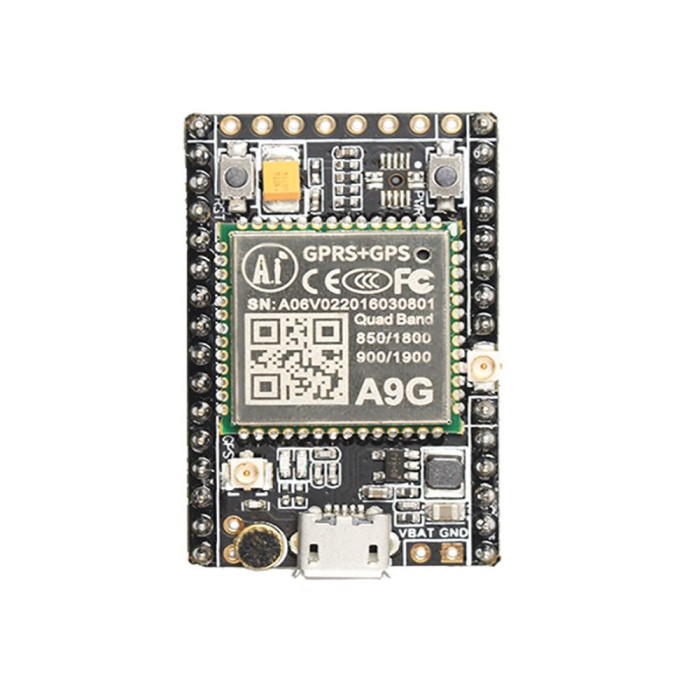The A9G development board is a multifunctional development board based on EMC™s A9G GPRS/ GSM + GPS/ BDS module, you can use it to verify the basic communication and peripheral functions of A9G module. It has the basic phone/ SMS, GPRS networking communications and GPG/ BDS dual mode positioning function. There are lithium battery charge management, microphone, speaker interface, USB communication interface, multiple user keys/ led, TF card slot, acceleration sensor, SPI interface, I2C2 interface, ADC interface on the boards, so you can develop different functions with this board.
The Ai-Thinker A9G is a compact and versatile module developed by Ai-Thinker. It is designed to provide integrated GSM/GPRS and GPS functionalities, making it suitable for a range of applications that involve cellular communication and global positioning.
Features of AI Thinker A9G development board
- 32 bit RISC core, frequency up to 312MHz, with 4k instruction cache, 4k data cache
- Up to 29 GPIOs (with two download pins)
- PMU(Power Management Unit): Lithium battery charge management, integrated DC-DC and LDOs
- Quad-band GSM/GPRS (850/900/1800/1900MHz)
- Voice call (microphone & speaker interface)
- SMS
- GPRS Class 10
- GPS integrated(GK9501), connected with GPRS chip internal through the serial port(UART2), real-time positioning
- ADC interface (2 pins)
- Various interfaces (I2C, SPI, UART, USB, TF card slot)
- Can be connected to an external 30W/200W camera using camera expansion board.
A9G is a complete quad-band GSM/GPRS+GPS module based on the RDA8955 chip. Integrating protocol stacks such as GSM/GPRS inside, this module supports the basic phone voice call/SMS, serial to GPRS and
Based on the above functions, A9G can be used for a variety of peripheral prototype development verification:
- Vehicle anti-theft device using GPRS+GPS and acceleration sensor.
- Remote monitoring intercom using GSM and microphone/speaker
- Smart watch using GPRS/GSM+GPS, 1.54-inch capacitive touch screen
- Elderly monitoring watch using GPRS/GSM+GPS, heart rate blood oxygen sensor, 1.54 inch capacitive touch screen
- Remote surveillance camera using GPRS+TF+ camera expansion board
Specification of AI Thinker A9G development board
- Working voltage 3.8V-4.2V, 4.0V power supply is recommended.
- Less than 2mA average current in low power mode.
- Support GSM/GPRS four frequency bands, including 850/900/1800/1900Mhz
- Sensitivity <-105;
- GPIO level is 2.8V;
- Support GPRS data service, maximum data rate, download 85.6Kbps, upload 42.8Kbps;
- Supports standard GSM07.07,07.05 AT commands and Ai-Thinker extended commands; ·A9G supports 3 serial ports, including 1 download serial port and 1 1 AT command port, 1 GPS serial port;
- AT commands support standard AT and TCP/IP command interfaces; · Support digital audio and analog audio, and support HR, FR, EFR, AMR voice coding.
AI Thinker A9G Module Pinout
The Ai Thinker A9G module has a specific pinout configuration that includes various GPIO (General Purpose Input/Output) pins, power supply pins, communication interfaces, antenna connectors (GPRS & GPS) and other essential connections. Here is a basic overview of the pinout for the Ai Thinker A9G dev. board module:

For more information about this module, please visit Ai Thinker A9G development board information.
How to connect A9G module to Arduino?
Connecting the Ai-Thinker A9G module to an Arduino board involves establishing a serial communication link between the two devices. Here's a basic guide on how to connect the A9G module to an Arduino. You can use any arduino board you wish such as Arduino Uno R3, Arduino Mega R3, or other models.
Step 1: Power Supply
Provide power to the A9G module within its specified voltage range. Connect the VCC pin of the A9G module to the 5V output of the Arduino. Connect the GND pin of the A9G module to the GND (ground) pin of the Arduino.
Step 2: Serial Communication:
The A9G module communicates with the Arduino via serial communication. Connect the TX (transmit) pin of the A9G module to one of the digital pins (e.g., pin 7) on the Arduino. Connect the RX (receive) pin of the A9G module to another digital pin (e.g., pin 8) on the Arduino. Also, connect the GND pin of the A9G module to the GND pin on the Arduino.
A9G TX -> Arduino RX (Digital Pin)
A9G RX -> Arduino TX (Digital Pin)
A9G GND -> Arduino GND
A9G VCC -> Arduino 5V
Step 3: Connet SIM Card
Insert a SIM card into the A9G module. Ensure that the SIM card is activated and not PIN-locked.
Step 4: Connect Antenna
Connect the appropriate antenna to the A9G module for GSM and GPS functionality.
Step 5: Upload Arduino Code
Write Arduino code to send AT commands to the A9G module and handle responses. Use the SoftwareSerial library to create a software serial port for communication with the A9G module.
#include
SoftwareSerial A9GSerial(7, 8); // RX, TX
void setup() {
Serial.begin(9600);
A9GSerial.begin(9600);
}
void loop() {
if (A9GSerial.available()) {
char c = A9GSerial.read();
Serial.write(c);
}
if (Serial.available()) {
char c = Serial.read();
A9GSerial.write(c);
}
}
This code creates a bridge between the Arduino's hardware serial (USB) and the A9G module using software serial.
Step 6: Testing
Upload the code to the Arduino and open the Serial Monitor. You can send AT commands through the Serial Monitor to interact with the A9G module and observe responses.

Can I use the A9G module for real-time GPS tracking?
Yes, the A9G module is designed to include GPS functionality, making it suitable for real-time GPS tracking applications. The module integrates both GPRS (General Packet Radio Service) and GPS (Global Positioning System) capabilities, providing a comprehensive solution for location-based tracking.
To use the A9G module for real-time GPS tracking, you'll typically need to follow these general steps:
- Connect it to an appropriate power source within the specified voltage range.
- Attach the GPS antenna to the designated connector on the A9G module
- Insert a SIM card into the A9G module.
- Communicate with the A9G module using AT commands. These commands can be sent via a microcontroller or a computer to configure and request information from the module.
- Configure the GPS settings using appropriate AT commands.
- Use GPRS functionality to transmit the GPS data to a server or a cloud platform in real-time. This may involve sending data over the internet to a designated endpoint.
- On the receiving end, process and interpret the GPS data to track the real-time location of the device equipped with the A9G module.
- Display the real-time GPS data on a user interface or store it for further analysis.
A9G or sim808, which one is better?
The choice between the A9G and SIM808 modules depends on your specific project requirements and preferences. Both modules offer GSM/GPRS and GPS functionalities, but they may have differences in terms of features, performance, and ease of use. Here are some considerations for each module:
A9G:
- Chipset: RDA8955 chip.
- Integration: GSM/GPRS and GPS functionalities.
- Cost-Effective: A9G is often considered cost-effective, making it suitable for projects with budget constraints.
- GPIOs and SDK: A9G comes with 29 GPIOs and an integrated SDK, offering flexibility for customization.
SIM808:
- Chipset: SIMCOM SIM808 chip.
- Industry Standard: SIM808 is widely used and has been a standard choice for GSM/GPRS and GPS applications.
- Community Support: SIM808 has been in the market for longer, so there might be more community support, libraries, and resources available.
Can I program A9G module itself?
Yes. You can program it using GPRS_C_SDK tool so it works standalone without any PC or microcontrollers. It provides a more comprehensive development environment for creating applications that leverage the module's GSM, GPS, and other functionalities. The A9G SDK supports the C programming language and provides libraries and examples to facilitate the development of custom applications for the module.
Key components and features you might find in the GPRS_C_SDK for Ai-Thinker A9G could include:
- APIs for GSM/GPRS Operations: The SDK may provide a set of APIs (Application Programming Interfaces) for interacting with the GSM and GPRS functionalities of the A9G module. These APIs allow developers to initiate voice calls, send SMS messages, and establish data connections.
- Sample Code and Examples: The SDK may include sample code and examples to demonstrate how to use the provided APIs in real-world scenarios. This can serve as a starting point for developers to build their applications.
- Documentation: Detailed documentation explaining the usage of the SDK, including API reference documentation, coding guidelines, and configuration settings for the A9G module.
- Tools: The SDK may come with tools to assist in tasks such as firmware flashing, configuration, and debugging.
- Integration with Development Environments: The SDK may be designed to work seamlessly with popular development environments to streamline the development process.
To access the GPRS_C_SDK and related resources for the Ai-Thinker A9G module, you would typically refer to the official Ai-Thinker documentation.
Is there any differences between sim808 and A9G module™s AT commands?
The AT command sets for SIM808 and A9G modules are generally similar since both modules are designed for GSM/GPRS and GPS functionalities. However, there can be some differences in specific commands or additional features, as different manufacturers may implement variations in their modules.
Here are some general guidelines:
SIM808 AT Commands:
SIMCOM, the manufacturer of SIM808, provides a detailed document known as the "SIM808 Series_AT Command Manual" or similar. This document outlines the AT command set for SIM808, covering both GSM/GPRS and GPS functionalities.
A9G AT Commands:
Ai-Thinker, the manufacturer of the A9G module, provides documentation that includes information on the AT command set for the A9G module.
Differences:
While the basic functionalities (e.g., sending SMS, making calls, configuring GPS) are likely to be similar between SIM808 and A9G, there could be differences in specific commands, configuration parameters, or additional features.
What is the baud rate of A9G?
The working baud rate of A9G module is 115200. If you send AT command to turn on GPS, GPS_ TXD will output information at 9600 baud rate, and the AT serial port is still 115200.
How should I power A9G module?
The Ai-Thinker A9G module should be powered within its specified voltage range to ensure proper operation. Here are the general steps to power the A9G module:
Check Voltage Requirements:
The A9G module typically operates within a specific voltage range, such as 3.4V to 4.4V. But this development board has stepdown regulator on VUSB/5V pin. So, you can also connect 5v power supply to it.
Use a Stable Power Supply:
Provide a stable power supply within the specified voltage range. This can be achieved using a regulated power supply or a battery with a voltage within the acceptable range.
Power On/Off Control:
This modules has a power key (PWR_KEY) that can be controlled to turn the module on and off.
What is the difference between AI thinker A9 and A9G?
Ai-Thinker GPRS module models are mainly A9, A9G. A9 mainly has GSM/GPRS (2G) related functions. A9G also integrates a GPS chip to facilitate the positioning related applications. For more functions, refer to hardware introduction section.









Please complete your information below to login.
Sign In
Create New Account